1K
The American Translators Association will hold its Annual Conference in San Antonio , Texas
Karen Tkaczyk will be presenting Beautiful Translations:Foundations for the Personal Care and Cosmetics Industry (ST-11, Friday, 4:00pm–5:00pm). The brief description from the conference website reads:
“This session will provide an overview of essential areas to understand in order to translate for the cosmetics, toiletries, soap, and detergent industry successfully. The speaker will introduce attendees to the regulatory affairs and key concepts behind the industry. A list of useful resources and reference material will also be provided.”
I asked Karen to provide us with a little more information. She started with a personal observation.
“There are areas that non-specialized translators readily refuse work in. Cosmetics and personal care products doesn’t seem to be one of those. Presumably by virtue of personal experience, and due to the ever-present consumer-oriented marketing and advertising we are exposed to, many translators feel they understand this business well enough to work in it, without really having the requisite background knowledge of the field. My goal in this session is to provide that necessary background so that people actually know what’s going on and, I hope, produce much better translations. I have spoken and written on this topic before for ATA (At the 2007–2008 conferences and in The Chronicle, September 2008), but that was long enough ago that it seemed timely to offer a session again, with updates for what has changed in the interim. For instance, the EU has made regulatory changes for cosmetics that came into effect this year.”
When asked who will benefit from his session, she replied:
I will break down the content into four areas:
- regulatory framework (let’s understand the rules)
- scientific and technical assessment (let’s understand the technical fields)
- ingredients (let’s understand the chemistry and engineering)
- marketing (let’s understand the hype)
This will be a high level review, given the time available, but I will provide an extensive resource list that should allow anyone who wants to target more clients in this area or become heavily specialized after the conference to do so efficiently, as they’ll have important links readily available.”
Coincidentally, someone told me years ago that translation constitutes a roughly two billion dollar market in the

